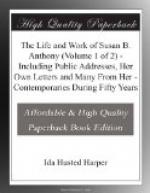She also relates how Miss Mott would come to her room and expound to her most beautifully the doctrine of Unitarianism, and then Mrs. Worthington would come and pray with her long and earnestly to counteract the pernicious effect of Miss Mott’s heresies. While she was accustomed to the liberal theology of the Hicksite Quakers, this was the first time she ever had heard the more scholarly interpretation of the Unitarian church.
From 1840 to 1845 Susan and Hannah taught almost continuously, receiving only $2 or $2.50 a week and board, but living with most rigid economy and giving the father all they could spare to help pay interest on the mortgage which rested on factory, mills and home. He gave his notes for every dollar and, years afterwards, when prosperity came, paid all of them with scrupulous exactness. It was in these early days of teaching that Miss Anthony saw with indignation the injustice practiced towards women. Repeatedly she would take a school which a male teacher had been obliged to give up because of inefficiency and, although she made a thorough success, would receive only one-fourth of his salary. It was the custom everywhere to pay men four times the wages of women for exactly the same amount of work, often not so well done.
Mr. Anthony went into his mills and performed the manual labor. In partnership with Dr. Hiram Corliss he employed a number of men to cut timber, going into the woods in the depths of winter personally to superintend them. His wife would cook great quantities of provisions, bake bread and cake, pork and beans, boil hams and roast chickens, and go to the logging camp with him for a week at a time, and she used to say that notwithstanding all the labor and anxiety of those days they were among the happiest recollections of her life.
At home the loom and spinning-wheel were never idle. The mill-hands were boarded, transient travelers cared for, and every possible effort made to enable the father to secure another foothold, but all in vain. The manufacturing business was dead, there was no building to call for lumber, people had no money, and, after a desperate struggle of five years, the end came and all was lost. Mr. Anthony then spent months in looking for a suitable location to begin life anew. He went to Virginia and to Michigan, but found nothing that suited him. He and his wife made a trip through New York, visiting a number of relatives on the way, and were persuaded to examine a farm for sale near Rochester. It proved to be more satisfactory than anything they had seen, and they decided to take it. Joshua Read who, during all these years, had carefully protected the portion which his sister, Mrs. Anthony, had inherited from their father, took this to make the first payment on the farm.[8] They then returned to Center Falls and began preparations for what in those times was a long journey.




